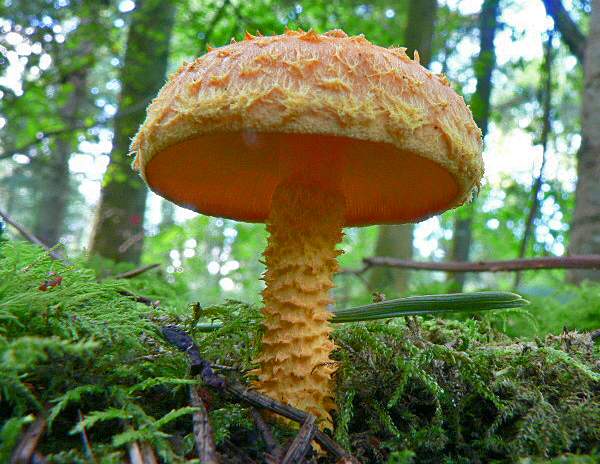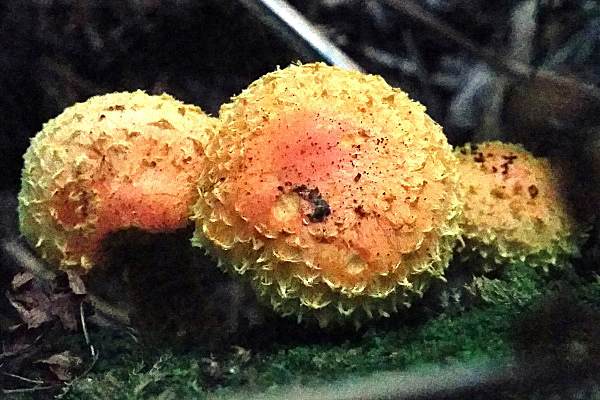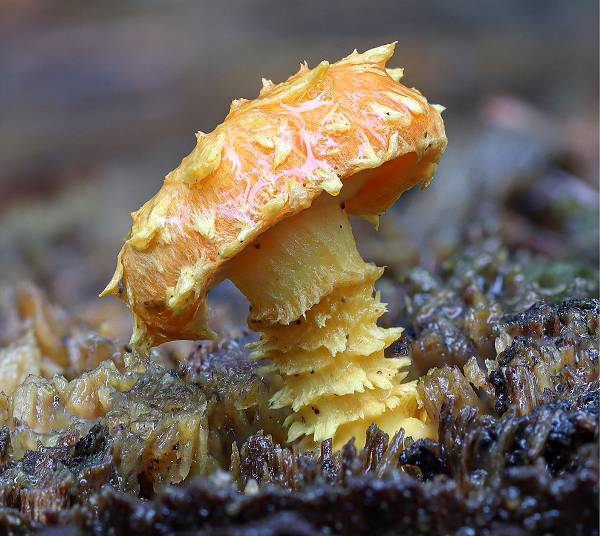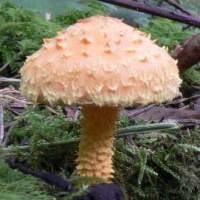Trees Birds Mammals Fish Amphibians Reptiles
Wild Algarve
Bookshop
Pholiota flammans (Batsch) P. Kumm. - Flaming Scalycap
Phylum: Basidiomycota - Class: Agaricomycetes - Order: Agaricales - Family: Strophariaceae
Distribution - Taxonomic History - Etymology - Identification - Culinary Notes - Reference Sources

Quite rare and certainly a special find, the Flaming Scalycap must count as one of Nature’s masterpieces. Monochrome orange all over, and with its cap and lower stem covered in upturned fleecy scales, it is as shaggy as Pholiota squarrosa that grows on the bases of living trees; however, the Flaming Scalycap is found only on dead wood, and nearly always rotting conifer stumps. Only occasionally growing in tufts, these fabulous forest fungi more often fruit singly.

Distribution
An uncommon but far from rare species in Britain and Ireland, Pholiota flammans is also found in northern and central mainland Europe as well as in Asia and parts of North America.
Taxonomic history
This lovely mushroom was described scientifically in 1783 by German mycologist August Johann Georg Karl Batsch (1761 - 1802), who named it Agaricus flammans. (In the early days of fungal taxonomy most gilled mushrooms were placed in the genus Agaricus, which was later broken up into the many other genera that we use today.) It was left to the famous German mycologist Paul Kummer to transfer this species to the Pholiota genus in 1871, renaming it Pholiota flammans.
Synonyms of Pholiota flammans include Agaricus flammans Batsch, and Dryophila flammans (Batsch) Quél.

Etymology
The generic name Pholiota means scaly, and the specific epithet flammans means flaming - now would you ever have guessed that?
Identification guide
 |
Cap
3 to 7cm across; bright golden yellow when young, maturing orange-yellow with upturned fleecy scales covering the entire cap surface; slimy beneath the scales; convex, becoming broadly convex but not flattening entirely.
Gills
Adnate; luminous orange-yellow.
Stem
4 to 8cm tall and 0.8 to 1.5cm dia.; orange; smooth above ring zone; covered in fibrous scales below. |
| |
Spores
Ellipsoidal to oblong, smooth, 4-5 x 2-3µm; with a distinct germ pore..
Spore print
Rusty brown. |
Odour/taste |
Odour not distinctive; taste very bitter. |
Habitat & Ecological role |
Most commonly on rotting conifer stumps, fallen trunks and dead roots, but also occasionally on dead wood of broadleaf trees, notably birches, Betula spp., and Beech, Fagus sylvatica. |
Season |
June to November in Britain and Ireland. |
Similar species |
Pholiota squarrosa has much larger, darker scales on its cap, and it grows most often on damaged areas of the lower trunks of living trees. |
Culinary Notes
Despite their attractive appearance, these and other scalycaps (Pholiota species) are definitely not edible mushrooms, although in the past some members of this genus were considered to be so.
Reference Sources
Fascinated by Fungi, 2nd Edition, Pat O'Reilly 2016, reprinted by Coch-y-bonddu Books in 2022.
British Mycological Society (2010). English Names for Fungi
Funga Nordica, Henning Knudsen and Jan Vesterholt, 2008.
Dictionary of the Fungi; Paul M. Kirk, Paul F. Cannon, David W. Minter and J. A. Stalpers; CABI, 2008
Taxonomic history and synonym information on these pages is drawn from many sources but in particular from the British Mycological Society's GB Checklist of Fungi.
Acknowledgements
This page includes pictures kindly contributed by Jane Davies, Richard Haynes and Tony Mellor.
Top of page...
Fascinated by Fungi. Back by popular demand, Pat O'Reilly's best-selling 450-page hardback book is available now. The latest second edition was republished with a sparkling new cover design in September 2022 by Coch-y-Bonddu Books. Full details and copies are available from the publisher's online bookshop...